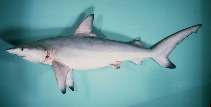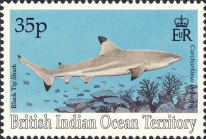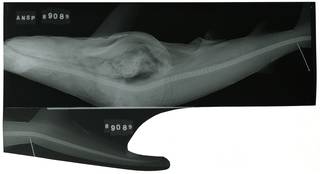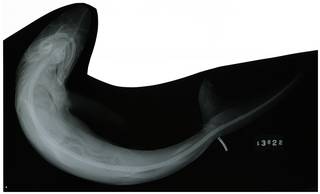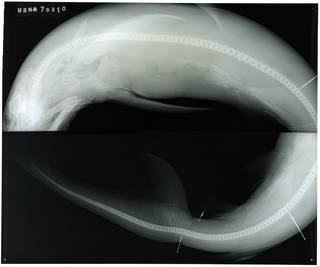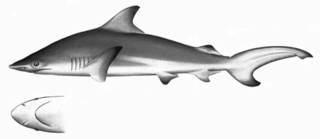WoRMS taxon details
Carcharhinus limbatus (Müller & Henle, 1839)
105793 (urn:lsid:marinespecies.org:taxname:105793)
accepted
Species
Carcharhinus aethalorus (Jordan & Gilbert, 1882) · unaccepted (junior synonym)
Carcharhinus natator Meek & Hildebrand, 1923 · unaccepted
Carcharias abbreviatus Klunzinger, 1871 · unaccepted
Carcharias aethalorus Jordan & Gilbert, 1882 · unaccepted
Carcharias ehrenbergi Klunzinger, 1871 · unaccepted
Carcharias limbatus Valenciennes, 1839 · unaccepted
Carcharias maculipinna Günther, 1868 · unaccepted
Carcharias microps Lowe, 1841 · unaccepted
Carcharias muelleri Steindachner, 1867 · unaccepted
Carcharias phorcys Jordan & Evermann, 1903 · unaccepted
Carcharias pleurotaenia Bleeker, 1852 · unaccepted (synonym)
Carcharinus limbatus (Valenciennes, 1839) · unaccepted (misspelling)
Eulamia aethalorus (Jordan & Gilbert, 1882) · unaccepted
Eulamia pleurotaenia (Bleeker, 1852) · unaccepted
Gymnorhinus abbreviatus (Klunzinger, 1871) · unaccepted
marine, brackish, fresh, terrestrial
Not documented
Description Found on the continental and insular shelves, commonly on turbid lagoons, inshore waters, estuaries, shallow muddy bays,...
Distribution Nova Scotia to Brazil
Description Found on the continental and insular shelves, commonly on turbid lagoons, inshore waters, estuaries, shallow muddy bays, and mangrove swamps at depths less than 30 m, occasionally found in passes or outer reef slopes. Young are common along beaches (Ref. 9710). Active hunter in midwater (Ref. 5485). Feeds mainly on fishes, less on cephalopods and crustaceans. Viviparous; litter size 1-10 pups; 38-72 cm at birth. Incriminated in very few attacks but dangerous when provoked. Pregnant females migrate to nursery areas (Ref. 9710). Often taken by shore anglers (Ref. 5485). Used fresh for human consumption, hides for leather, liver for oil. [details]
Distribution Nova Scotia to Brazil
Distribution Nova Scotia to Brazil [details]
Froese, R. and D. Pauly. Editors. (2024). FishBase. Carcharhinus limbatus (Müller & Henle, 1839). Accessed through: World Register of Marine Species at: https://www.marinespecies.org/aphia.php?p=taxdetails&id=105793 on 2024-04-18
Date
action
by
![]() The webpage text is licensed under a Creative Commons Attribution-Noncommercial 4.0 License
The webpage text is licensed under a Creative Commons Attribution-Noncommercial 4.0 License
context source (Deepsea)
Intergovernmental Oceanographic Commission (IOC) of UNESCO. The Ocean Biogeographic Information System (OBIS), available online at http://www.iobis.org/ [details]
context source (HKRMS) Hong Kong marine fish database. <em>AFCD.</em> , available online at https://www.hk-fish.net/en/fish/introduction/ [details]
context source (PeRMS) Chirichigno, N.; Cornejo, M. (2001). Catálogo comentado de los peces marinos del Perú. <em>2ª ed. Instituto del Mar de Perú. Publicación Especial. Callao.</em> 314 p. [details]
basis of record van der Land, J.; Costello, M.J.; Zavodnik, D.; Santos, R.S.; Porteiro, F.M.; Bailly, N.; Eschmeyer, W.N.; Froese, R. (2001). Pisces, <B><I>in</I></B>: Costello, M.J. <i>et al.</i> (Ed.) (2001). <i>European register of marine species: a check-list of the marine species in Europe and a bibliography of guides to their identification. Collection Patrimoines Naturels,</i> 50: pp. 357-374 (look up in IMIS) [details]
additional source Florida Museum of Natural History. 2003. Ichthyology Collection Database., available online at http://www.flmnh.ufl.edu/fish/Collection/collectdata.htm [details]
additional source McEachran, J. D. (2009). Fishes (Vertebrata: Pisces) of the Gulf of Mexico, Pp. 1223–1316 in: Felder, D.L. and D.K. Camp (eds.), Gulf of Mexico–Origins, Waters, and Biota. Biodiversity. Texas A&M Press, College Station, Texas. [details]
additional source Liu, J.Y. [Ruiyu] (ed.). (2008). Checklist of marine biota of China seas. <em>China Science Press.</em> 1267 pp. (look up in IMIS) [details] Available for editors [request]
[request]
additional source Froese, R. & D. Pauly (Editors). (2023). FishBase. World Wide Web electronic publication. version (02/2023)., available online at https://www.fishbase.org [details]
context source (HKRMS) Hong Kong marine fish database. <em>AFCD.</em> , available online at https://www.hk-fish.net/en/fish/introduction/ [details]
context source (PeRMS) Chirichigno, N.; Cornejo, M. (2001). Catálogo comentado de los peces marinos del Perú. <em>2ª ed. Instituto del Mar de Perú. Publicación Especial. Callao.</em> 314 p. [details]
basis of record van der Land, J.; Costello, M.J.; Zavodnik, D.; Santos, R.S.; Porteiro, F.M.; Bailly, N.; Eschmeyer, W.N.; Froese, R. (2001). Pisces, <B><I>in</I></B>: Costello, M.J. <i>et al.</i> (Ed.) (2001). <i>European register of marine species: a check-list of the marine species in Europe and a bibliography of guides to their identification. Collection Patrimoines Naturels,</i> 50: pp. 357-374 (look up in IMIS) [details]
additional source Florida Museum of Natural History. 2003. Ichthyology Collection Database., available online at http://www.flmnh.ufl.edu/fish/Collection/collectdata.htm [details]
additional source McEachran, J. D. (2009). Fishes (Vertebrata: Pisces) of the Gulf of Mexico, Pp. 1223–1316 in: Felder, D.L. and D.K. Camp (eds.), Gulf of Mexico–Origins, Waters, and Biota. Biodiversity. Texas A&M Press, College Station, Texas. [details]
additional source Liu, J.Y. [Ruiyu] (ed.). (2008). Checklist of marine biota of China seas. <em>China Science Press.</em> 1267 pp. (look up in IMIS) [details] Available for editors
additional source Froese, R. & D. Pauly (Editors). (2023). FishBase. World Wide Web electronic publication. version (02/2023)., available online at https://www.fishbase.org [details]
 Present
Present  Present in aphia/obis/gbif/idigbio
Present in aphia/obis/gbif/idigbio  Inaccurate
Inaccurate  Introduced: alien
Introduced: alien  Containing type locality
Containing type locality
From other sources
Description Found on the continental and insular shelves, commonly on turbid lagoons, inshore waters, estuaries, shallow muddy bays, and mangrove swamps at depths less than 30 m, occasionally found in passes or outer reef slopes. Young are common along beaches (Ref. 9710). Active hunter in midwater (Ref. 5485). Feeds mainly on fishes, less on cephalopods and crustaceans. Viviparous; litter size 1-10 pups; 38-72 cm at birth. Incriminated in very few attacks but dangerous when provoked. Pregnant females migrate to nursery areas (Ref. 9710). Often taken by shore anglers (Ref. 5485). Used fresh for human consumption, hides for leather, liver for oil. [details]Diet Feeds mainly on pelagic and benthic fishes, also small sharks and rays, cephalopods and crustaceans [details]
Distribution Nova Scotia to Brazil [details]
Habitat nektonic [details]
Habitat Found at depths of 0 - 30m. [details]
Importance Social- Commercial, fishery, l, liver oil, and hide used for leather [details]
Remark In Müller & Henle. [details]
| Language | Name | |
|---|---|---|
| English | blacktip shark | [details] |
| German | kleiner Schwarzspitzenhai | [details] |
| Hebrew | כריש שחור-שוליים | [details] |
| Japanese | カマストガリザメ | [details] |
| Lithuanian | mažasis juodapelekis ryklys | [details] |
| Modern Greek (1453-) | Μελανόακρος καρχαρίνος | [details] |
| Polish | żarłacz czarnopłetwy | [details] |
| Portuguese | tubarão-de-pontas-negras | [details] |
| Spanish | tiburón voladortiburón macuirajaquetón manchado | [details] |
| Turkish | köpek balığıkopek baligicamgözcamgoz | [details] |
| Ukrainian | Акула сіра чорнопера | [details] |
To Barcode of Life (172 barcodes)
To Biodiversity Heritage Library (1 publication) (from synonym Carcharias abbreviatus Klunzinger, 1871)
To Biodiversity Heritage Library (1 publication) (from synonym Eulamia pleurotaenia (Bleeker, 1852))
To Biodiversity Heritage Library (12 publications) (from synonym Carcharinus limbatus (Valenciennes, 1839))
To Biodiversity Heritage Library (16 publications) (from synonym Carcharias microps Lowe, 1841)
To Biodiversity Heritage Library (17 publications) (from synonym Carcharias limbatus Valenciennes, 1839)
To Biodiversity Heritage Library (4 publications) (from synonym Carcharias pleurotaenia Bleeker, 1852)
To Biodiversity Heritage Library (5 publications) (from synonym Carcharias ehrenbergi Klunzinger, 1871)
To Biodiversity Heritage Library (54 publications)
To Biodiversity Heritage Library (7 publications) (from synonym Carcharhinus natator Meek & Hildebrand, 1923)
To Biodiversity Heritage Library (7 publications) (from synonym Carcharias aethalorus Jordan & Gilbert, 1882)
To Biodiversity Heritage Library (8 publications) (from synonym Carcharias phorcys Jordan & Evermann, 1903)
To Biological Information System for Marine Life (BISMaL)
To European Nucleotide Archive (ENA)
To FishBase (from synonym Carcharhinus natator Meek & Hildebrand, 1923)
To FishBase (from synonym Carcharias aethalorus Jordan & Gilbert, 1882)
To FishBase
To FishBase (from synonym Carcharias muelleri Steindachner, 1867)
To FishBase (from synonym Carcharias phorcys Jordan & Evermann, 1903)
To FishBase (from synonym Gymnorhinus abbreviatus (Klunzinger, 1871))
To FishBase (from synonym Carcharinus limbatus (Valenciennes, 1839))
To FishBase (from synonym Carcharias abbreviatus Klunzinger, 1871)
To FishBase (from synonym Carcharias ehrenbergi Klunzinger, 1871)
To FishBase (from synonym Carcharias limbatus Valenciennes, 1839)
To FishBase (from synonym Carcharias maculipinna Günther, 1868)
To FishBase (from synonym Carcharias microps Lowe, 1841)
To Fishbase (from synonym Eulamia aethalorus (Jordan & Gilbert, 1882))
To FishBase (from synonym Carcharias pleurotaenia Bleeker, 1852)
To FishBase (from synonym Eulamia pleurotaenia (Bleeker, 1852))
To FishBase images (Carcharhinus limbatus, Bahrain, by Randall, J.E.)
To GenBank (322 nucleotides; 183 proteins)
To GenBank (322 nucleotides; 183 proteins) (from synonym Carcharias limbatus Valenciennes, 1839)
To Global Biotic Interactions (GloBI)
To IUCN Red List (Vulnerable)
To NMNH Extant Collection (Carcharhinus limbatus RAD107048-001)
To NMNH Extant Collection (Carcharhinus limbatus RAD107052-001)
To NMNH Extant Collection (Carcharhinus natator RAD107055-001) (from synonym Carcharhinus natator Meek & Hildebrand, 1923)
To NMNH Extant Collection (Carcharhinus natator RAD107055-001) (from synonym Carcharhinus natator Meek & Hildebrand, 1923)
To NMNH Extant Collection (Carcharias phorcys P02110 illustration) (from synonym Carcharias phorcys Jordan & Evermann, 1903)
To PESI
To ITIS
To Biodiversity Heritage Library (1 publication) (from synonym Carcharias abbreviatus Klunzinger, 1871)
To Biodiversity Heritage Library (1 publication) (from synonym Eulamia pleurotaenia (Bleeker, 1852))
To Biodiversity Heritage Library (12 publications) (from synonym Carcharinus limbatus (Valenciennes, 1839))
To Biodiversity Heritage Library (16 publications) (from synonym Carcharias microps Lowe, 1841)
To Biodiversity Heritage Library (17 publications) (from synonym Carcharias limbatus Valenciennes, 1839)
To Biodiversity Heritage Library (4 publications) (from synonym Carcharias pleurotaenia Bleeker, 1852)
To Biodiversity Heritage Library (5 publications) (from synonym Carcharias ehrenbergi Klunzinger, 1871)
To Biodiversity Heritage Library (54 publications)
To Biodiversity Heritage Library (7 publications) (from synonym Carcharhinus natator Meek & Hildebrand, 1923)
To Biodiversity Heritage Library (7 publications) (from synonym Carcharias aethalorus Jordan & Gilbert, 1882)
To Biodiversity Heritage Library (8 publications) (from synonym Carcharias phorcys Jordan & Evermann, 1903)
To Biological Information System for Marine Life (BISMaL)
To European Nucleotide Archive (ENA)
To FishBase (from synonym Carcharhinus natator Meek & Hildebrand, 1923)
To FishBase (from synonym Carcharias aethalorus Jordan & Gilbert, 1882)
To FishBase
To FishBase (from synonym Carcharias muelleri Steindachner, 1867)
To FishBase (from synonym Carcharias phorcys Jordan & Evermann, 1903)
To FishBase (from synonym Gymnorhinus abbreviatus (Klunzinger, 1871))
To FishBase (from synonym Carcharinus limbatus (Valenciennes, 1839))
To FishBase (from synonym Carcharias abbreviatus Klunzinger, 1871)
To FishBase (from synonym Carcharias ehrenbergi Klunzinger, 1871)
To FishBase (from synonym Carcharias limbatus Valenciennes, 1839)
To FishBase (from synonym Carcharias maculipinna Günther, 1868)
To FishBase (from synonym Carcharias microps Lowe, 1841)
To Fishbase (from synonym Eulamia aethalorus (Jordan & Gilbert, 1882))
To FishBase (from synonym Carcharias pleurotaenia Bleeker, 1852)
To FishBase (from synonym Eulamia pleurotaenia (Bleeker, 1852))
To FishBase images (Carcharhinus limbatus, Bahrain, by Randall, J.E.)
To GenBank (322 nucleotides; 183 proteins)
To GenBank (322 nucleotides; 183 proteins) (from synonym Carcharias limbatus Valenciennes, 1839)
To Global Biotic Interactions (GloBI)
To IUCN Red List (Vulnerable)
To NMNH Extant Collection (Carcharhinus limbatus RAD107048-001)
To NMNH Extant Collection (Carcharhinus limbatus RAD107052-001)
To NMNH Extant Collection (Carcharhinus natator RAD107055-001) (from synonym Carcharhinus natator Meek & Hildebrand, 1923)
To NMNH Extant Collection (Carcharhinus natator RAD107055-001) (from synonym Carcharhinus natator Meek & Hildebrand, 1923)
To NMNH Extant Collection (Carcharias phorcys P02110 illustration) (from synonym Carcharias phorcys Jordan & Evermann, 1903)
To PESI
To ITIS
